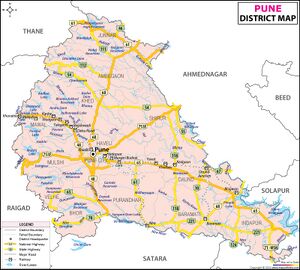Rajgarh Maharashtra
| Author:Laxman Burdak, IFS (R) |

Rajgarh (राजगढ़) is a hill fort situated in the Pune district of Maharashtra, India.
Variants
- Rajgarh Maharashtra राजगढ़, महाराष्ट्र, (AS, p.779)
- Rajgad
Location
The Rajgad Fort is located around 60 km to the south-west of Pune and about 15 km west of Nasrapur in the Sahyadris range.
History
Formerly known as Murumdev, the fort was the capital of the Maratha Empire under the rule of Chhatrapati Shivaji for almost 26 years, after which the capital was moved to the Raigad Fort.[1] Treasures discovered from an adjacent fort called Torna were used to completely build and fortify the Rajgad Fort.
The fort's ruins consist of palaces, water cisterns, and caves. This fort was built on a hill called Murumbadevi Dongar (Mountain of the Goddess Murumba). Rajgad boasts of the highest number of days stayed by Chhatrapati Shivaji on any fort.
The fort has stood witness to many significant historic events including the birth of Chhatrapati Shivaji's son "Rajaram Chhatrapati", the death of Shivaji's Queen Saibai, the return of Chhatrapati Shivaji from Agra, the burial of Afzal Khan's head in the Mahadarwaja walls of Balle Killa, the strict words of Sonopant Dabir to Shivaji.
The Rajgad Fort was also one of the 17 forts that Chhatrapati Shivaji kept when he signed the Treaty of Purandar in 1665, with the Mughal general Jai Singh I, leader of the Mughal forces. Under this treaty, 23 forts were handed over to the Mughals.
राजगढ़, महाराष्ट्र
राजगढ़, महाराष्ट्र, (AS, p.779): महाराष्ट्र में स्थित एक ऐतिहासिक दुर्ग है। यह तोरण के दुर्ग से 6 मील दूर मोरबंद नामक पर्वतश्रंग पर स्थित है। इस दुर्ग की स्थापना 1646 ई. के लगभग छत्रपति शिवाजी द्वारा की गई थी। राजगढ़ के दुर्ग को बनवाने के लिए शिवाजी को तोरण दुर्ग से प्राप्त गढ़े हुए खजाने से काफ़ी सहायता मिली थी।[2] ने
External links
References
- ↑ Prof. A. R. Kulkarni (1 July 2008). "Rajgad: The first capital of Shivaji". Medieval Maratha Country. Diamond Publications. ISBN 978-81-8483-072-9.
- ↑ Aitihasik Sthanavali by Vijayendra Kumar Mathur, p.779

